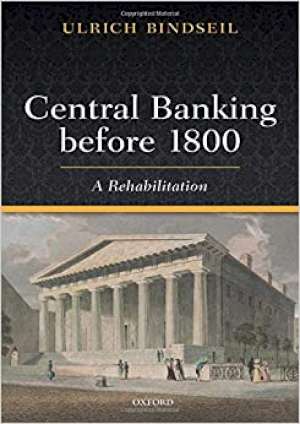26 November 2020
Central banking before 1800
Ulrich Bindseil
2019, Oxford University Press, 336 pages,
ISBN 9780198849995
Reviewer: William A Allen

You might expect ‘Central banking before 1800’ to be a rather short book. If so, Ulrich Bindseil challenges your expectation. His objective is to contest the widespread belief that central banking as we know it began with the Bank of England’s gradual and reluctant acceptance of a public responsibility to act as lender of last resort in the second half of the nineteenth century. It is worth noting that he is the Director-General of Market Infrastructure and Payments in the European Central Bank; it is remarkable that he has found the time and energy to write the book.
Bindseil’s challenge is based on his chosen definition of a central bank as an institution which issues ‘financial money of the highest possible credit quality, which is accepted for settlement of any other financial claim in the same way as species [sic] money is accepted (i.e. it is considered credit, liquidity, and market risk free, to use modern terminology)’ (p 2).
The definition is problematic. It implies that during the gold standard period, a central bank was a bank whose liabilities were considered as good as gold. However, central banks had to deal periodically with internal drains – heavy redemptions of their notes by people who feared devaluation or loss of convertibility of notes. Did they cease to be central banks during such episodes? Moreover, consider:
• The Bank of England from 1939 to 1979. It issued pounds, whose transferability was restricted by exchange controls, and whose value was eroded by continuous inflation. Was it a central bank?
• The large European, North American and Japanese commercial banks, in the period from the 1980s until the early 21st century. Their credit standing was unquestioned, if only because they were thought to be too big to fail, and deposits with them were accepted anywhere as a means of payment. Were they not central banks?
Bindseil’s evidence for his challenge takes the form of a series of descriptions of banks which operated before 1800, and which he claims were central banks according to his definition. For example, he describes how the Hamburger Bank lent to the merchants of Hamburg in 1763, at the end of the Seven Years’ War, during the crisis initiated by falling asset prices and the failure of traders in Amsterdam to whom the Hamburg merchants were exposed. The additional lending did not put the Hamburger Bank under particular credit stress, because the bank had been highly liquid at the outset: hence its liabilities were of the highest quality. This, he claims, makes the Hamburger Bank a central bank.
However, the Hamburger Bank’s lending did not prevent fifty bank failures in August 1763: it was described by other authors (on whose account Bindseil partly relies) as ‘a drop in the ocean.’ Many of the banks re-opened later and repaid their liabilities. If the Hamburger Bank was a central bank, it wasn’t a very effective one, because it didn’t provide enough liquidity to keep the payments system running. Bindseil does not show that the Hamburger Bank’s actions amounted to anything more than the behaviour of a private banker constructively addressing the problems of customers who were temporarily distressed but fundamentally solvent.
None of Bindseil’s historical accounts is original, but by assembling them all in the same place, he is able to identify and discuss common issues, such as those arising from lending to governments and to private borrowers, and from last-resort lending. He shows that the present-day problems of central banks have long historical antecedents. These discussions are, for me, the most interesting part of the book.
More generally, Bindseil certainly demonstrates that the services that central banks have customarily provided since the 19th century were also needed before 1800, and that at least some of them were provided, some of the time. That is interesting in itself. He does not dispute that the role of the Bank of England changed fundamentally in the half-century after the Bank Charter Act of 1844 had failed completely to break the series of financial crises that had occurred in the preceding twenty years, and that the Bank of England thereby became something recognisable to modern eyes as a ‘central bank’. Ultimately, though, the issue that preoccupies Bindseil seems to me to be a sterile one:
‘What’s in a name? That which we call a rose
By any other name would smell as sweet.’
There is much interesting material in Bindseil’s book, but its insistence on definitional issues is an unfortunate and unnecessary distraction.
